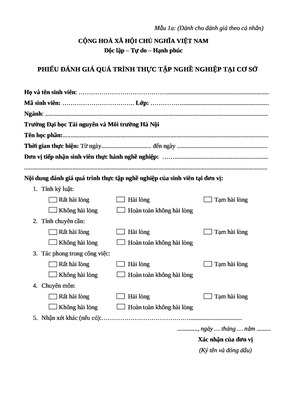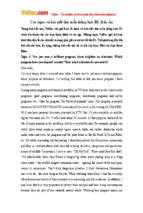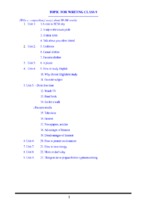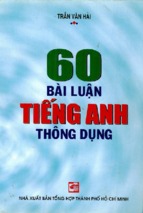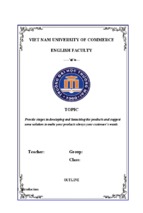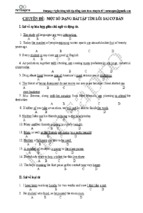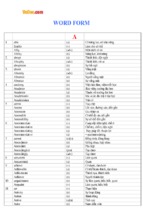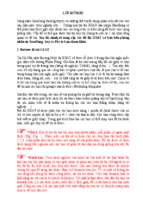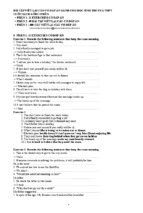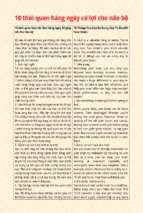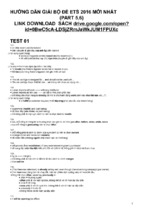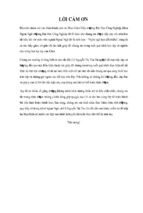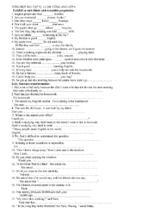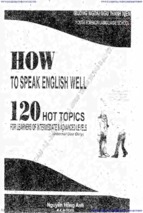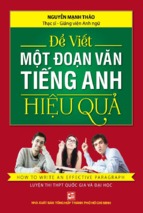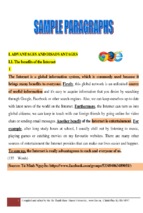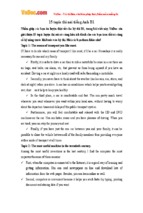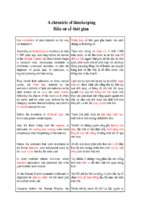341. POLLUTION
NAÏN OÂ NHIEÃM
Pollution has been defined as the addition of any substance or form of energy to the
environment at a rate faster than the environment can accommodate dispersion,1
breakdown, recycling or storage in some harmless form. In simpler terms, pollution
means the poisoning of the environment by Man.
Pollution has accompanied mankind ever since groups of people settled down in one
place for a long time. It was not a serious problem during primitive times when there
was more than ample space available for each individual or group. As the human
population boomed,2 pollution became a major problem and has remainded one ever
since. Cities of ancient times were often unhealthy places, fouled by human wastes and
debris.3 Such unsanitary conditions favoured the outbreak of diseases that killed or
maimed4 many people living in those times.
The rapid advancement of technology and industrialization today is something that Man
can be proud of. However, it has brought along with it many undesirable results, one of
which is the pollution of our environment. Humanity today is threatened by the dangers
of air, water, land and noise pollution.
The air that we breathe is heavily polluted with toxic gases, chemicals and dust. These
consists of the discharge from industrial factories and motor vehicles. The emission5 of
tetraethyl lead and carbon monoxide from exhaust fumes is a major cause for concern
too. Outdoor burning of trash and forest fires have also contributed to air pollution. They
cause the smarting of the eyes, bouts of coughing and respiratory problems. Owing to
the burning of fossil fuels, the level of carbon monoxide in the air is more than
desirable. Too high a level of carbon dioxide will cause the Earth's temperature to rise.
The heat will melt the polar caps, thus raising the sea level and causing massive flood
around the world. The burning of fuels also produces gases which form acid rain. Acid
rain has a damaging effect on water, forest and soil, and is harmful to our health.
Man has reached the moon and invented supersonic crafts that can travel faster than the
speed of sound. However, these inventions emit pollutants which contribute to the
depletion of the ozone layer. This depletion of ozone, which absorbs the harmful rays of
the sun and prevents them from reading the Earth, will have drastic effects on all living
things. It will lead to a rise in the number of people suffering from skin cancer.
Water pollution has become widespread too. Toxic waste has found its way into our
lakes, streams, rivers and oceans. This waste is released by factories and sea-going
vessels. Spillage6 of oil by tankers and during the recent Gulf War has caused
irreparable7 damage to marine8 life. Thousands of sea animals have died or were
poisoned by the pollutants in their natural habitat. As such, it is dangerous for humans to
consume sea food caught in polluted waters.
Dumping of used cars, cans, bottles, plastic items and all other kinds of waste material is
an eyesore. Much of the refuse9 is not biodegradable10 and this interferes with the
natural breakdown process of converting substances from a harmful form to a non
harmful one. As such, it becomes a hazard to one's health.
We are often faced with noises from construction sites, jet planes and traffic jam. We
may be unaware of it but noise pollution has been attributed to causing a loss of hearing,
mental disturbances and poor performance at work.
To control environmental pollution, substances which are hazardous and can destroy life
must not be allowed to escape into the environment. This calls dangers of pollution.
1. dispersion /d1'sp3:~n/ (n) söï taùn saéc
2. boom /bu:m/ (v) buøng noå, boäc phaùt
3. debris /'de1bri:/ (n) maûnh vôõ, vaät ñoå naùt
4. maim /me1m/ (v) laøm taøn taät, laøm taøn pheá
5. emission /'1m1~n/ (n) söï toûa ra, söï thaûi ra
6. spillage /'sp1l1d2/ (n) söï ñoå ra
7. irreparable /1'rep6r6bl/ (adj) (veà toån thaát, veát thöông, v.v…) khoâng theå ñeàn buø hay hoài phuïc
8. marine /m6'ri:n/ (adj) thuoäc veà bieån, do bieån sinh ra
9. refuse /'refju:s/ (n) raùc röôûi, vaät pheá thaûi
10. biodegradable /ba16$d1'9re1d6bl/ (adj) (veà nhöõng chaát) coù theå bò thoái röûa do vi khuaån
342. MAN IS POLLUTING HIS ENVIRONMENT. DISCUSS
CON NGÖÔØI ÑANG LAØM OÂ NHIEÃM MOÂI TRÖÔØNG SOÁNG. HAÕY THAÛO LUAÄN
Ever since the first atom bomb was burst in the Arizona desert, scientists have become
aware of the radioactive fall-outs1 from the bursting of megaton bombs by nuclear
nations and subsequently the pollution of water by nuclear reactors. But this is not the
first time that air and water are being polluted. For quite a long time it has been going
on, especially, since the coming of the petroleum to be used in the internal combustion
engines.2 Oil in whatever form consumes the life-giving oxygen of the air and the end
products mainly carbon dioxide fills up the atmosphere. The green parts of plants clear
up this debris, consume the carbon in the process of photosynthesis3 and bring back the
oxygen. There is a limit to this reaction. When the percentage of carbon dioxide in the
atmosphere grows beyond some tolerance level, even all the green plants of the world
will not be up to the task. Add to it the careless denudation of forest and wooded areas
which are destroyed for the sake of industries.
The results of such pollution are something like this. The atmospheres gets heated and
the average temperature may go beyond what it is ; as a result ice in the oceans may
melt increasing the level of the seas and so the low-lying areas may be submerged. The
water in the seas get evaporated4 sooner and upset the balance.
Another thing that pollutes the air is dust particles.5 Dust particles and smoke in the air
act as nucleus6 for the water vapour in the atmosphere to condense and form what is
called 'smog'. This causes poor visibility to the motor car drives and is a great handicap
for aeroplanes to land and take off.
The pollution of water is equally serious, still it is growing at a rapid pace. Chemical
wastes from factories and nuclear reactors are drained into rivers, lakes and seas. At
first the water becomes unfit for drinking. Where the water has not been properly
sterilised, it has led to serious epidemics7 like jaundice.8 Furthermore it tells on the
aquatic life, both plants and animals. Fishes die or they carry small doses of radioactive
elements in them that those who consume them may die ; so too in the case of plants.
This has caught the eye of the public in the U.S.A. that recently the Americans observed
what is called the Earth Day or Environment Control Day. They have become aware of
it and the government, the labour force, students and artists are involved in fighting
against such pollution. In many of the States, they raised loud voices that the
government has come forward to do something. For instance, in his State of the Union
address once President Nixon said : "The great question of the seventies is, shall we
surrender9 to our surroundings or shall we make our peace with nature and begin to
make reparations for the damage we have done to our air, land and water."
There was much talk on Earth Day about closing the loop. The terms will have much
significance in the future as science and technology turn more attention to progress that
will take man's waste and recycle it into the system thereby making better use of what
already had been taken from the earth and conserving the resources that are left.
If man does not act now, the ecological1 systems will breakdown creating diseases man
cannot resist, loss of food supplies from lakes and seas, the necessity of gas masks
whenever one goes outside. Can it happen ? Obviously, it can and will, if man fails to
act right from now.
1. radioactive fall-out /re1d16$,%kt1v 'f0:la$t/ (n) buïi phoùng xaï
2. internal combustion engine /1n,t3:nl k6m,b^st~n 'end21n/ (n) ñoäng cô ñoát trong
3. photosynthesis /f6$t6$'s1n86s1s/ (n) söï quang hôïp
4. evaporated /1'v%p6re1t1d/ (adj) bò boác hôi
5. particle /'p@:t1kl/ (n) moät phaàn töû nhoû (cuûa caùi gì)
6. nucleus /'nju:kl16s/ (n) haït nhaân
7. epidemic /ep1'dem1k/ (n) beänh dòch
8. jaundice /'d20:nd1s/ (n) beänh vaøng da, beänh hoaøng ñaûn
9. surrender /s6'rend6(r)/ (v) ñaàu haøng, töø boû
10. ecological /i:k6'l4d21kl/ (adj) thuoäc veà sinh thaùi hoïc
343. POLLUTION-HOW TO REDUCE IT
NAÏN OÂ NHIEÃM VAØ BIEÄN PHAÙP HAÏN CHEÁ
The world that we live in now is badly affected by pollution. The rivers and seas are
polluted. The air is polluted. The land is polluted. Consequently the things we drink,
breathe in and eat are all polluted.
This sad state of affairs do not good for our health and well-being. Pollution is virtually
destroying the place we live in - Earth. If pollution is allowed to go on and on we will
surely destroy ourselves too. We ought to value our planet for it is only place we can
live in. If we destroy it then we are also finished.
Eliminating pollution completely is impossible. So it is important that we try to keep
pollution to a minimum. There are many things that we can do to reduce it.
The very first thing for everyone is to stop dumping1 rubbish anywhere they like.
Throwing rubbish seems to be the favourite pastime of everyone. So we see piles of
rubbish on road sides, in ditches and drains, in backlanes and often on main roads too.
What rubbish do people throw away ? Empty cans and bottles, sweet wrappers, plastic
bags full of smelly stuff, dead animals, broken toys, broken TV sets, food, old cars and
kitchen sinks are item that can be found in the rubbish dumps. Perhaps we could recycle
the things we use instead of simply throwing them away. We could, for example, reuse
glass, metals and plastics. We could cook only what is necessary instead of throwing
what we could not eat. We could keep our cars and sinks in good working order instead
of abusing them as many of us do now. Then we would have less rubbish to throw.
Consequently there would be less rubbish dumps and less pollution.
Motor vehicles are a major cause of air pollution. They emit much exhaust fumes. In big
cities this pollution has reached levels that pose2 a threat3 to the health of the city
dwellers. Some cities have already advised their residents to wear gas masks when they
venture onto the streets. The only way to reduce this pollution is obviously to reduce the
number of vehicles on the roads. This is easier said than done for very few people
would want to sacrifice the convenience of having one's own transport.
Factories and industrial plants are largely responsible for pollution of the air, water and
land. The waste they discharge4 into the rivers and land destroy both. The smoke they
emit pollutes the air. What they must do is to find ways to reduce their wastes. Also they
have to treat their wastes so that they emit. All these things are required if we are to see
any reduction of pollution. At the rate things are going however, we see increase in
pollution instead.
Whether we can really reduce pollution and thus save our planet is up to us. Pollute it
more and we shall perish.
1. dump /d^mp/ (v) vöùt boû
2. pose /p6$z/ (v) laøm cho (caùi gì) xuaát hieän, taïo ra hoaëc ñöa ra
3. threat /8ret/ (n) söï ñe doïa
4. discharge /d1st~@:d2/ (v) tuoân ra (chaát loûng, hôi, v.v…)
344. MEN'S ENEMIES IN THE WORLD OF NATURE
KEÛ THUØ CUÛA NHAÂN LOAÏI TRONG THEÁ GIÔÙI TÖÏ NHIEÂN
Somebody has observed that man is born free but everywhere he is in chains. Though
this was said in some other circumstances, man is not so free. From birth to death he has
to contend1 with his enemies. Where the enemy is known, man has always found ways
and means of combating it. If it is disease, he has medicines for it. He would set up
snares2 and catch certain types of enemies. He would kill them with slings, bows and
arrows, spears and guns and so on. But the story of man, when he cannot fight his
enemy, is helplessness as in the case of a big storm.
Among the animate enemies, the bacteria and virus are the worst for one does not know
when they may strike for they are lurking everywhere only to enter the human system
and play havoc. Long, long tried to appease them by offering sacrifices and by
worshipping them. Now thanks to the advance of science and invention of scientific
instruments especially the microscope and the X-Ray machines, man knows diseases
are caused by bacteria and virus. He knows also how to prevent falling prey to those
diseases. He has in his repertoire3 sulpha drugs and antibiotics, vaccines and serums.
Almost all epidemic diseases have become things of the past. For instance, small pox,
the scourge which was taking away a toll of men has been eradicated practically from
the face of the earth. Only cancer is defying all treatmen.
Man has to be wary4 about insects that bite because he cannot hope to eradicate them.
From experience he has come to know of medicines for such stings, for example snake
bites can be treated with serum.
Man has enemies among animals such as the tigers, wolves and foxes. They don't attack
man unless he interferes with them. These animals have their part to play in the
ecological belance. Even the dog, man's best friend, can prove as an enemy especially
when it becomes mad. The bite of mad dog causes rabies, thanks to the pioneering effort
of Louis Pasteur and anti-rabies, vaccine has been prepared and has proved a blessing in
healing dog bites.
There are also other type of enemies which destroy man's food. For example, rats and
other rodents5 destroy sezable quantities of grains and fruits. But man from experience
and scientific skills has overcome these enemies. He builds rat proof warehouses where
grains are dusted with chemicals so that they don't rot. He keeps food items in cold
storage and thus preserve them.
There are then the enemies from the very elements themselves. The life giving
atmosphere may prove fearsome when it turns into a storm or tornado. With scientific
instruments man is able to forecast a coming storm. Similarly, the rain, snow, ice and
frost may prove to be enemies when they occur. Rain destroys life and property and
leaves destruction when it recedes. Fog has caused many a disaster on land and water
such as ships colliding, air crashes and land accidents. Ice was known to have broken
ships. But the dangers from them are being minimised because of sophisticated
apparatus man has at his command. Mother earth herself very often makes up her mind
to heave and shake. These earthquakes do cause a heavy loss almost every year.
The worst enemy of man is death. One does not know what death is except that all the
organs fail to function. Man may argue as to how death is caused, but nevertheless it
does occur at every age and in all places at all times. There is none who is not afraid of
death. People carry mascots6 and talismans7 to avoid death.
The mystery of death is so deep that a lot of theories have sprung up about it. It may be
a friend in certain cases and it may appear cruel in other cases. Whether death is an
enemy or friend depends on how one views it.
So one can conclude that man is always surrounded by enemies and if at all he survices,
it is indeed a miracle.
1. contend /k6n'tend/ (v) ñaáu tranh (ñeå chieán thaéng moät ñoái thuû, moät khoù khaên, v.v…)
2. snare /sne6(r)/ (n) caùi baãy (duøng baãy chim hoaëc caùc con thuù nhoû)
3. repertoire /'rep6tw@:(r)/ (n) kho, voán
4. wary /'we6r1/ (v) caûnh giaùc
5. rodent /'r6$dnt/ (n) loaøi gaëm nhaám
6. mascot /'m%sk6t/ (n) vaät laáy phöôùc
7. talisman /'t%l1zm6n/ (n) buøa, phuø
345. THE HARVEST OF THE SEA
THU HOAÏCH TÖØ LOØNG BIEÅN CAÛ
Ordinarily harvest refers to the return or income which a farmer gets from the field.
There may be a bumper harvest. Nevertheless the harvest is the end product of long
waiting, back breaking operations, involving a lot of skill and patience. In the case of the
sea also there is a similarity connected with the harvest in the field; the only difference
being there is not a question of ploughing, preparing the field and sowing. But a good
harvest in the sea means a great deal of risk and danger. It means pluck and courage on
the part of those who take to sea life.
Let us take a look at the exact harvest of the sea. The foremost thing that comes into the
mind is the fish. Fishing in the sea is a major industry of the world and maritime
countries and their people depend on fish for food. There are major fishing grounds of
the world, notably the North Sea, off the coast of New Foundland and British, Columbia
and the sea of Japan. In these countries they have mechanised fishing. Fish is caught on
a large scale and canned to be sent to the markets.
Besides fish, the whale1 is hunted for its flesh and blubber2 as well as it's bones. Whale
hunting is a dangerous job because that mammal, yes, whale is not a fish in the real
sense, can destroy a boat if it strikes. A whole novel 'Moby Dick' had been dedicated to
whale hunting.
The floor3 of the sea has not been exploited. There is a belief that the deep floors of the
seas must be rich in minerals. When the minerals on the land is exhausted, perhaps man
may turn to the sea bed for his resources. There is, of course, mineral oil found in some
places in the sea bed. Already some countries have taken up the idea and have started
prospecting for oil in the sea.
Beside the economic value of the life from the sea, children enjoy picking the beautiful
shells deposited on the shore by waves.
The sea too can be used for producing food. The green plankton4 which produces starch
can be exploited to stem the hunger of the world.
If the harvest of the sea is taken to mean in a wider sense, water transport then can also
be the bloodstream of the world's commerce. Wide arteries5 of shipping lines have
liners loaded with the world's merchandise. Till the advent of the aeroplane, the ship
was the only link connecting countries divided by the seas. For transporting heavy cargo
there is nothing better than sea transport.
Another important item of harvest is the energy that could be produced by using the tidal
waves. There are countries where these tidal waves play havoc. But these waves could be
suitably harnessed6 to produce power. This possibility has not been ruled out and there
are attempts afoot to tap this source. This is how man gets a good harvest from the sea.
1. whale /we1l/ (n) caù voi
2. blubber /'bl^b6(r)/ (n) môõ (caù voi vaø cuûa caùc ñoäng vaät khaùc ôû bieån/duøng ñeå thaép saùng)
3. floor /fl0:(r)/ (n) ñaùy (bieån, thung luõng, v.v…)
4. plankton /'pl%7kt6n/ (n) sinh vaät phuø du
5. artery /'@:t6r1/ (n) ñöôøng giao thoâng chính
6. harness /'h@:n1s/ (v) cheá ngöï, khai thaùc (ñeå saûn xuaát naêng löôïng)
346. DISCUSS THE PART PLAYED BY SCIENCE IN THE PROMOTION OF
PUBLIC HEALTH DURING THE LAST HUNDRED YEARS
HAÕY THAÛO LUAÄN VAI TROØ CUÛA KHOA HOÏC TRONG VIEÄC NAÂNG CAO SÖÙC
KHOÛE QUAÀN CHUÙNG SUOÁT MOÄT TRAÊM NAÊM QUA
One of the most striking features of the present century is the progress of science and its
effects on almost every aspect of social life. Building on the foundations laid by their
predecessors1 the scientists of today are carrying their investigation into ever widening
fields of knowledge.
The contribution of science to the promotion of public health in the last hundred years
has indeed been tremendous. The unceasing work and experiments of scientists during
this time have led to numerous discoveries and removed many misconceptions that
many people had before, regarding health illness. The causes of many of the diseases
have become generally known. Indeed, many of the facts relating to public health,
which are now regarded as common knowledge, were unknown even to the doctors of
those days. The fact that germs were the cause of most of the common diseases was not
realised by doctors of high repute in the not very distant past. Today, however, even a
pupil of a primary school has some knowledge of the destruction that germs can cause.
The discovery of germs has indeed revolutionised all medical concepts of disease and
illness. Everywhere people have come to realise the importance of cleanliness in the
prevention of disease.
The researchers or scientists of all countries have also revealed other secrets. It is now
known that illness and diseases can be caused by other living creatures also, such as
flies, insects and even birds, animals and human beings. Their discoveries have
contributed to the progress of medical science. Today, people in all parts of the world
are doing their utmost to destroy the creatures that carry diseases. At the same time,
however, scientists have also discovered that certain animals and creatures could
provide some cure for a variety of diseases that are dangerous to human beings. Even
the curative2 value of certain plants has been discovered.
An important result of the discoveries of scientists has been that, they have also found
the cure of almost every disease. It is a practice of the scientists to work for the
discovery of a cure as soon as they have discovered the causes of a certain disease. This
service of the scientists has promoted the welfare of the human race. In this field of
research, scientists make no distinction between races. Whatever they discover is used
for the advantage of men everywhere. The progress of humanity is their main aim.
The work of medical scientists also reduced pain to great extent. In the past,
operations3 were performed on individuals in a very crude manner. Amputation4 was a
very painful affair. Today, however, the whole body of a man could be cut open without
his feeling any pain by the use of chloroform. In this way science has relieved the
misery of men tremendously.
Another very important discovery has been that, water, without which life cannot exist,
sometimes contains the elements of destruction as well. Impure water could spread
disease and death at tremendous speed. This knowledge has led people in all parts of
the world to use only pure water for all domestic and other purposes. Water is
considered so important a factor in public health that all the governments of the world
control its use for drinking purposes.
All these discoveries have indeed promoted public health during the last hundred years.
1. predecessor /'pri:d1ses6(r)/ (n) ngöôøi ñi tröôùc, ngöôøi tieàn nhieäm
2. curative /'kj$6r6t1v/ (adj) coù khaû naêng hoaëc duøng ñeå chöõa beänh
3. operation /4p6're1~n/ (n) vieäc phaåu thuaät; ca moå
4. amputation /%mpj$'te1~n/ (n) vieäc caét boû (tay, chaân) baèng phaåu thuaät
347. "ADVERTISEMENTS ARE BORING, USELESS AND OFTEN
MISLEADING." HOW FAR DO YOU AGREE WITH THIS OPINION ?
“QUAÛNG CAÙO RAÁT NHAØM CHAÙN, VOÂ DUÏNG VAØ THÖÔØNG GAÂY LAÀM LAÃN”. BAÏN
ÑOÀNG YÙ VÔÙI YÙ KIEÁN NAØY ÔÛ MÖÙC ÑOÄ NAØO ?
Advertisement is highly developed nowadays. To some extent, nature itself advertises
her wares; for instance, the colour and smell of flowers is nothing but advertisement to
attract the attention of insects and birds and the promise of honey is the gift.
Advertising is one of the media to draw the attention of the public and to educate them
regarding a particular product. This is called the psychology of persuasion in converting
people to a way of life or thinking. For example, to introduce a new drink, it is not
enough if the product is good, the public should be made to realize its existence. The
manufacturer adopts subtle ways of advertising. It must appeal visually. Since
advertisement has become very important and the methods used are many, it has
become a very professionalised trade today. In fact advertising agencies do good
business. Since they employ specialists like artists and script writers, the advertiser can
have expert service at a price.
There are hundreds of ways of advertising. Generally they may have visual, audio and
audio-visual appeal. Leaflets and brochures are produced describing a colourful product.
Free samples are given, so that new customers may be found. Calendars are quite
common and there are very plain ones to picturesque1 ones. Some fine calendars are
being preserved. So calendar manufacturing during the end of the year season is a big
business.
Perhaps one of the most popular medium of advertisements is the newspaper, since they
reach a very wide section of the public. Some products are advertised throughout the
year and they generate a source of income for the newspaper. Here the picture and the
script play a very important part. Nowadays small gifts like key chains, purses, table
wares and so on are used to advertise.
If the same advertisements are issued2 for too long they become boring. The advertiser
knows this, so he changes the mode of advertisement from time to time. Either the
pictures may be changed or the script. Sometimes subtle sex appeal is thrown in by
advertising agencies. Whether this is ethically3 correct is a debatable point.
Any advertisement cannot be useless. It has got a purpose. An advertiser can use a ton
of paper for printing his advertisement and distributing it to various houses to get the
message of his product across. Throwing to the public just like throwing some mud on
the wall, some of it is sure to stick. So too with advertisement which brings the
prospective buyer and the product man nearer. With a complex market with dozens of
products competing, advertisement is one of the ways of winning the market.
Of course there are advertisements which are really misleading. Some medicines that
are advertised claim to be panacea for all bodily ills but very few products claim that
honour. Some of the products are not of that high quality as claimed by the
advertisement. Take for instance, some of the advertisements for toothpaste. They claim
to give all protection to the teeth but they are proven otherwise. In USA this subtle way
of persuading the public has been questioned and number of products advertised did not
stand the test of proof.
We can conclude here that in spite of its limitations, advertisement is a powerful media
that has come to stay.
1. picturesque /p1kt~6'resk/ (adj) ñeïp ñeõ, xinh ñeïp
2. issue /'1~u:/ (v) phaùt haønh, ñöa ra
3. ethical /'e81kl/ (adj) ñuùng ñaén veà ñaïo ñöùc
348. HOW TO SHOP WISELY
CAÙCH THÖÙC MUA SAÉM KHOÂN NGOAN
All of us, except for some very few, use money to buy what we need in this world. We
do our shopping in various places. Sometimes we are satisfied with what we buy.
Sometimes though we do not get our money's worth and we feel cheated. To avoid
being cheated we have to know how to shop wisely.
To shop wisely simply means not wasting our money on useless goods. We have to be
careful with what we buy. While we cannot make absolutely sure that what we buy are
really worth our money, we can reduce our risks of buying faulty goods to a minimum.
Here are some suggestions on how to do it.
It is good practice to check the price of the goods first. Shops are required by law to
display price tags1 for all items. Goods that have no price tags are suspect and ought to
be avoided. Also it is better if we compare the prices of the goods at various places. We
will probably be shocked by the price differences. The money saved on finding the best
deal is usually worth the time spent on it.
Next the expiry2 date of perishable goods should be checked. Items without expiry
dates or that have expired should not be bought. It is silly to buy a cheap can of sardines
at a much reduced price only to discover that the contents are inedible when we open it.
The condition of the goods that we intend to buy should be checked. For example, cans
should be examined for dents3 and rust.4 If the cans show any of these signs then they
should not be bought. Often the contents of such cans will be unsatisfactory too.
Vegetables and meat should be examined for freshness. Do not be fooled by the
attractive packaging. See the item itself and make sure it is worth the money.
When buying something that has to be weigded, it is a good idea to witness the weighing
ourselves. Also ensure than the needle reads zero when there is nothing on the balance.
It is all too easy to the short-weighed.
When paying for things bought at the counter, it is good practice to make sure that the
prices are correctly entered. Keep the receipt in case we want to return or exchange
anything. Count the change after paying for what we buy. There are many unscrupulous
traders who short-change customers.
Finally we should only buy what we need. All too often we are taken in by attractive
sales gimmick and buy things we never use. This is sheer waste of money. Also
perishable goods will perish if kept too long. It is better to buy fresh things than to
discard old useless ones. In this way we spend our hard-earned money wisely and not
waste it.
1. tag /t%9/ (n) nhaõn haøng, baûng giaù
2. expiry /1k'spa16r1/ (n) söï heát haïn - expire /1k'spa16(r)/ (v) heát haïn, maõn haïn
3. dent /dent/ (n) veát loõm
4. rust /r^st/ (n) ræ, ræ seùt
349. WHAT CLOTHES TELL ABOUT PEOPLE
Y PHUÏC PHAÛN AÙNH CON NGÖÔØI
Clothes can tell us a great deal about a person's background, his social status, his
aesthetic taste, his mood and also about the climatic conditions he ordinarily lives in.
They can also indicate whether he has been recently bereaved or not; at times it is
possible to find out the marital status1 of women by the way they dress. If a person is
wearing black it is indicative of some bereavement. Of course now black bands are also
worn to indicate resentment of the policies of a firm or an association. White is
associated with a large number of emotional states. In many Asian societies it is
considered to be a colour of mourning and amongst the orthodox Hindus white is the
colour of widowhood. At the same time white stands for purity and chastity. White is the
colour for bridal dress in the West. In tropical countries it is a colourful scene that meets
the eye. The lush greenery of the landscape in Malaysia, in Singapore and in Burma is
matched by the floral designs of the sarong and the bright colours of the blouses and the
umbrellas. Bright coloured clothes besides providing a contrast to the greenery, also
absorb the heat and are cooler to wear. Similarly it has been noticed that people living
in sand coloured surroundings of the desert are inclined to dress up gaily and are
conspicuous2 amidst their surroundings.
The quality of the material used and the tailoring at once indicate the social status of the
man. If the clothes are of a good quality but are worn and threadbare then obviously the
man has fallen on evil times. If they are new but not well cut and the wearer doesn't
carry them with ease then it would be fair to say that here is an upstart who is learning
the ways of the rich. Poets and bohemians carry clothes with a subtle indifference and
cultured women impart a grace all their own to the clothes they wear irrespective of3
the quality or the cost of the clothes. It should be understood that in the tribal world, the
aborigines4 do not pay excessive heed to clothes. They belong to the world of
civilization and consciousness ; they belong to the post-lapsarian period when Adam and
Eve had become acquainted with good and evil. The European gypsies - though
colourfully dressed do not make dress their prime concern. In the civilized and highly
sophisticated societies, however, clothes have acquired a disproportionate importance.
Sartorial5 differences have been minimized to a very great extent. The use of synthetic
fibres and cheaper imitations of expensive garments have flooded the market. Imitation
furs and jewellery add to this effort of camouflaging. It is not always possible to judge
correctly the social background of a person due to these reasons. People are consciously
dressing according to the accepted standard in order to benefit from class prejudices.
Though this may pass in many cases, the truly naive6 and the truly sophisticated don't
join in this effort and even if the naive do they are not successful. For when a man fresh
from a rural background tries to acquire an urban exterior, the rest of his behaviour will
give him away.
Clothes, like language, can be used both for deception and expression. They can express
a personallity transparently : they can also help achieve a disguise and carry through a
deception. If the attempt is to deliberately deceive people, clothes can go a long way in
doing this and this hypocritical behaviour may one day become the reality. As far as
human integrity is concerned it is best to follow Thoreau's advice : "Beware of all
enterprises that require new clothes", for clothes may well destroy the man within.
1. marital status /,m%r1tl 'ste1t6s/ (n) tình traïng hoân nhaân
2. conspicuous /k6n'sp1kj$6s/ (adj) deã thaáy, thu huùt söï chuù yù
3. irrespective (of) /1r1'spekt1v/ (prep) khoâng keå, baát chaáp
4. aborigines /%b6'r1d26ni:z/ (n) thoå daân
5. sartorial /s@:'t0:r16l/ (adj) thuoäc caùch aên maëc
6. naive /na1'i:v/ (n) ngöôøi ngaây thô, caû tin, khôø khaïo
350. "GOOD DESIGN MUST SUIT THE MATERIAL USED." DISCUSS THE
STATEMENT WITH REFERENCE TO ANY ONE ART OR CRAFT
“KIEÅU DAÙNG ÑEÏP PHAÛI PHUØ HÔÏP VÔÙI CHAÁT LIEÄU SÖÛ DUÏNG”. THAÛO LUAÄN
QUAN ÑIEÅM NAØY VAØ LIEÂN HEÄ VÔÙI MOÄT NGAØNH THUÛ COÂNG MYÕ NGHEÄ NAØO ÑOÙ
Good dressing adds to a person's personality. When an ordinary man goes in for
something costly, people think that he is in borrowed glories even though he may have
bought those things out of his own hard earned money. The opposite is also true. When a
rich man appears in really borrowed garb1 or ordinary clothes people think highly of
him. We have a certain measure of standard by which we appraise things.
So too in the case of designs. Its value is enhanced when it is transposed on to a good
base. A statuette of fine workmanship in clay may not be so much appreciated as one
done in ivory. The value of the design appears more because of the material used. In the
same way an idol in bronze or alloy may be valued more than if it is done in stone. Even
there we apply a different scale. If the stone is marble instead of granite, the statue is
highly valued. This is only to show that the same design in different materials has
different values.
Now let us take the case of jewellery. Many kinds of materials are used and the value
varies from a few cents to a few thousands of dollars. In making a jewel the artist uses
the material according to the price he can get. Thus the costume jewellery used by cineartists2 8 is cheap. In front of foot-lights they glitter like expensive jewellery. Cheap
metals and polished glass are used in them. Beautiful items like necklaces, bangles,3
pendants4 and so on are made like the original pieces but their value is very low. On the
other hand, we see beautiful and magnificent designs in gold and silver but because of
the material used the design is appreciated.
This has a moral. One is known by the company he keeps. If he is found among
ruffians,5 scoundrels and villians he is also one of them, though he may be different and
may be a good one. There is a saying, 'If one drinks milk under the plamyra tree, he is
taken to drink toddy'. So too in the case of designs. Good design and good material
should go together.
1. garb /9@:b/ (n) (kieåu) quaàn aùo (ñöôïc moät lôùp ngöôøi naøo ñoù maëc)
2. cine-artist /'s1n1 ,@:t1st/ (n) dieãn vieân ñieän aûnh
3. bangle /'b%79l/ (n) voøng trang söùc ñeo ôû coå tay/chaân
4. pendant /'pend6nt/ (n) maët daây chuyeàn
5. ruffian /'r^f16n/ (n) ñöùa coân ñoà, voâ laïi, löu manh
351. "WHY BOTHER TO PAINT WHEN YOU CAN PHOTOGRAPH ?"
COMMENT
“TAÏI SAO PHAÛI MAÁT COÂNG VEÕ KHI TA COÙ THEÅ CHUÏP AÛNH ?” HAÕY BÌNH LUAÄN
The statement deals with two aspects of art namely photography and painting. They are
complementary to each other.
Photography, nowadays has supplanted painting because it is a more faithful
reproduction of the model, person, thing or scenery. Photography is based on a scientific
principle, and provided1 the mechanism in a camera does not fail, excellent results are
produced. The camera has been improved to a very great extent so that more life like
pictures could be taken even by an amateur photographer. Photography saves time. In a
matter of minutes pictures are taken. Nowadays colour pictures are taken. Fast films and
powerful lenses2 make it easy to take pictures even in the darkness. The cine industry
has added a momentum to the growth of photography. If the chemicals are properly
treated on a film a photograph can be kept to the end of time. That is why great
documents and books in the national archives are being photographed. Whereas paper
spoils too soon, films do not.
With all its favourable points, photography cannot score over paiting. The latter is
something personal and in great master-pieces, we see the personality of the painter.
The painter sets the tone in colour, creates moods and he is a student of emotions in that
he could reproduce them in his paintings. In order to do that he must be a student of
human nature. Every facial expression, every movement of the muscle, every twinkle in
the eye or the contortion of the lips catches his trained eye. The expressions in the
human face are kaleidoscopic,3 still once the painter catches an expression, he will
never forget it and given the chance, he immortalizes it in his pictures.
In short the painter is a creative artist. He knows the value of his colours and he is
master of every stroke of his brush. He is an actual creator. One or two examples would
illustrate this point. In Mysore in India, there is a picture of a women with an oil lamp in
her hand. The flame illumines her face. Unless you look at it twice you won't understand
it. But if you look at it from a distance a whole world of art is before you. What a lovely
expression. This painting has won the appreciation of the whole world. After all, this
painting has no riot4 of colours. Still it can bring out a whole world of emotions.
The camera may do the same job but it is devoid of emotions. We get a feast of good
photography in famous cinema pictures. A cameraman must wait to take particular
scenes. The shots may come up or may not when developed. There are chances for
mechanical failures. A photographer may spoil a picture which cannot be caught at that
precise moment again. He may bring about distortions by taking at wrong angles.
Photography cannot displace the painting for a painted picture is a reflection of the
personality of the painter and subject. The same can never be said of photography. That
is why we speak of "schools" of painting and not "schools" of photography.
1. provided (that) /pr6'va1d1d/ (conj) mieãn laø, vôùi ñieàu kieän laø
2. lens /lenz/ (n) thaáu kính
3. kaleidoscopic /k6la1d6s'k4p1k/ (adj) söï bieán aûo thöôøng xuyeân veà maãu hình
4. riot (of sth) /'ra16t/ (n) söï phoâ baøy thöøa thaõi (caùi gì)
352. THE ONLY THING PEOPLE ARE INTERESTED TODAY IS EARNING
MORE MONEY. DISCUSS
ÑIEÀU DUY NHAÁT CON NGÖÔØI QUAN TAÂM TÔÙI TRONG THÔØI ÑAÏI NGAØY NAY
LAØ KIEÁM ÑÖÔÏC NHIEÀU TIEÀN HÔN. HAÕY THAÛO LUAÄN
Once upon a time there lived a beautiful young woman and a handsome young man.
They were very poor, but as they were deeply in love, they wanted to get married. The
young people's parents shook their heads. "You can't get married yet" they said. "Wait
till you get a good job with good prospects". So the young people waited until they found
good jobs with good prospects and they were able to get married. They were still poor,
of course. They didn't have a house to live in or any furniture, but that didn't matter. The
young man had a good job with good prospects, so large organizations lent him the
money he needed to buy a house, some furniture, all the latest electrical appliances and
a car. The couple lived happily ever after paying off debts for the rest of their lives. And
so ends another modern romantic fable.
We live in a materialistic society and are trained from our earliest years to be acquisitive.
Our possessions, "mine" and "yours" are clearly labelled from early childhood. When we
grow old enough to earn a living, it does not surprise us to discover that success is
measured in terms of the money you earn. We spend the whole of our lives keeping up
with our neighbours, the Joneses. If we buy a new television set, Jones is bound to buy a
bigger and better one. If we buy a new car, we can be sure that Jones will go one better
and get two new cars : one for his wife and one for himself. The most amusing thing about
this game is that the Joneses and all the neighbours who are struggling frantically to keep
up with them are spending borrowed money kindly provided, at a suitable rate of interest,
of course, by friendly banks, insurance companies, etc...
It is not only affluent societies that people are obsessed with the idea of making more
money. Consumer goods are desirable everywhere and modern industry deliberately
sets out to create new markets. Gone are the days when industrial goods were made to
last forever. The wheels of industry must be kept turning "built-in obsolescence"1
provides the means : goods are made to be discarded. Cars get tinnier2 and tinnier. You
no sooner acquire this year's model that you are thinking about is replacement.
This materialistic outlook has seriously influenced education. Fewer and fewer young
people these days acquire knowledge only for its own sake. Every course of studies
must lead somewhere : i.e. to a bigger wage packet. The demand for skilled personnel
far exceeds the supply and big companies compete with each other to recruit3 students
before they have completed their studies. Tempting salaries and "fringe benefits" are
offered to them. Recruiting tactics4 of this kind have led to the "brain drain", the process
by which highly skilled people offer their services to the highest bider. The wealthier
nations deprive their poorer neighbours of their most able citizens. While common is
worshipped as never before, the rich get richer and the poor, poorer.
1. built-in obsolescence /,b1lt1n 4bs6'lesns/ (n) tính loãi thôøi ñaõ ñöôïc hoaïch ñònh tröôùc (cuûa
moät saûn phaåm), töùc laø ñöôïc ngöôøi cheá taïo chuû taâm thieát keá ñeå khoâng beàn laâu, nhaèm
khuyeán khích khaùch haøng laïi mua nöõa
2. tiny /'t1n1/ (adj) (veà ñoà baèng kim loaïi) khoâng beàn hoaëc khoâng chaéc chaén
3. recruit /r1'kru:t/ (v) tuyeån (nhaân vieân, v.v…)
4. tactics /'t%kt1ks/ (n) chieán thuaät
- Xem thêm -

